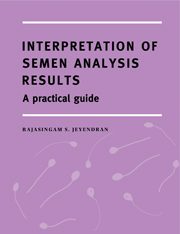Book contents
- Frontmatter
- Contents
- Preface
- Introduction
- Hypotheses on fertile ejaculate identification
- Male reproductive system background
- Semen analysis interpretation
- ROUTINE SEMEN ANALYSIS
- SPECIALIZED SEMEN ANALYSIS
- The logical sequence of routine and specialized semen analysis
- Semen component point-of-origin
- Conclusion
- Standard semen variable reference values for clinical interpretation and diagnosis (Table 1)
- Specialized semen test reference values for clinical interpretation and diagnosis (Table 2)
- Spermatozoa biochemical analysis and seminal plasma chemical analysis reference values for clinical interpretation and diagnosis (Table 3)
- Glossary
- Suggested additional reading
- Index
SPECIALIZED SEMEN ANALYSIS
Published online by Cambridge University Press: 05 August 2016
- Frontmatter
- Contents
- Preface
- Introduction
- Hypotheses on fertile ejaculate identification
- Male reproductive system background
- Semen analysis interpretation
- ROUTINE SEMEN ANALYSIS
- SPECIALIZED SEMEN ANALYSIS
- The logical sequence of routine and specialized semen analysis
- Semen component point-of-origin
- Conclusion
- Standard semen variable reference values for clinical interpretation and diagnosis (Table 1)
- Specialized semen test reference values for clinical interpretation and diagnosis (Table 2)
- Spermatozoa biochemical analysis and seminal plasma chemical analysis reference values for clinical interpretation and diagnosis (Table 3)
- Glossary
- Suggested additional reading
- Index
Summary
When the spouse is found to be normal (within range of existing diagnostic techniques), and if the standard semen analysis results are also within reference range, specialized tests are then recommended. Additionally, when the standard semen analysis results yield equivocal values (see Table 1) or are abnormal, specialized tests are also recommended.
These specialized tests are not routinely performed, and most of their reference values have yet to be firmly established. However, these tests can provide valuable diagnostic information concerning certain individuals.
Sperm function tests
The inherent ambiguity between sperm function and sperm property makes differentiation difficult, if not impossible. Clinical purpose and clarity demand that anything observed within, or evaluated about, an ejaculate constitutes a sperm property, such as motility. In contrast, any new observable sperm change or action induced by a particular stimulus, including an external factor or agent interaction, is classified as a sperm function. The following descriptions provide a logical array of ‘sperm function tests’.
Spermatozoa may appear normal but may not be able to penetrate and migrate through the cervical mucus and consequently cannot reach the fertilization site. Such migratory capacity or incapacity can be tested by allowing the sperm to penetrate and move through cervical mucus in vitro.
The biochemical events that allow sperm to fertilize are collectively called capacitation (see ‘Sperm-oocyte Interaction’ page 18). Capacitation primarily involves changes in the sperm membrane system and is a process that occurs when sperm are in the female reproductive tract. The sperm membrane must be intact and functional for these events to occur. The spermatozoa structural and functional integrity may be evaluated by exposing them to a non-penetrating dye or hypoosmotic medium.
To determine whether sperm capacitation has occurred, an acrosome reaction can be induced artificially. Alternatively, sperm can be added to isolated human zona pellucida or to zona free hamster oocytes and extent of binding or penetration determined. If spermatozoa are capacitated, they will undergo the acrosome reaction and bind or penetrate oocytes.
- Type
- Chapter
- Information
- Interpretation of Semen Analysis ResultsA Practical Guide, pp. 55 - 76Publisher: Cambridge University PressPrint publication year: 2000



